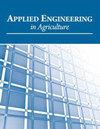Predicting Single Kernel Moisture and Protein Content of Mushroom Popcorn Using NIR Spectroscopy: Tool for Determining their Effect on Popping Performance
IF 0.8
4区 农林科学
Q4 AGRICULTURAL ENGINEERING
引用次数: 0
Abstract
HighlightsPrediction models for high accuracy measurement of single kernel (SK) moisture content (MC) and protein content (PC) were developed using near-infrared reflectance (NIR) spectroscopy.USDA-ARS tube SKNIR instrument sorted individual kernels based on single kernel protein content (SKPC) which enabled determining the effect of three PC levels within a popcorn variety on popping performance.Variety, MC, and PC affected popping expansion, ball rate, and number of unpopped/half-popped kernels.Within popcorn variety, increased PC significantly increased expansion and reduced number of unpopped kernels but did not affect ball rate of popped flakes.The ability to sort single kernels for specific quality parameter, such as PC, is an important and useful tool for popcorn breeders and processors to meet consumer demand for specialized products.Abstract. The increasing demand for specialized high-quality popcorn products necessitates that the popcorn industry continuously identify quality parameters that can be improved through plant breeding or manipulated or sorted for improved end-products. Relationships between protein content (PC) and popping performance (expansion, ball rate, and number of unpopped kernels) has been investigated but there has been no research on segregating individual kernels from within the same variety for specific PC ranges, which may eliminate possible interference from some underlying variety- or production-related effects. Prediction models for determination of single kernel moisture content (MC) and PC were developed for the USDA-ARS tube single kernel near infrared reflectance (SKNIR) instrument. Both parameters were predicted with high accuracies for independent validations. MC showed an R2 of 0.94 and SEP of 0.25% while PC had R2 of 0.92 and SEP of 0.35%. Popping tests showed that increased kernel PC significantly (p<0.05) increased expansion and lowered the number of unpopped kernels but had no effect on the ball rate of popped flakes. Thus, applications that require increased overall expansion and reduced number of unpopped kernels may be addressed by the removal of low protein popcorn kernels from a popcorn lot, which can be achieved using an automated SKNIR technique. The SKNIR technique also provides a means for plant breeders to work on targeted/specific PC or PC range based on the single kernel selection. Keywords: Ball rate, Expansion, Mushroom popcorn, NIR spectroscopy, Popcorn quality, Single kernel, Unpopped kernels.近红外光谱法预测蘑菇爆米花单粒水分和蛋白质含量:测定其对爆粒性能影响的工具
利用近红外反射(NIR)光谱技术建立了单粒(SK)水分含量(MC)和蛋白质含量(PC)的高精度预测模型。USDA-ARS管式SKNIR仪器根据单粒蛋白含量(SKPC)对籽粒进行分类,从而确定了不同籽粒蛋白水平对爆粒性能的影响。品种、MC和PC影响膨化膨胀、球率和未膨化/半膨化粒数。在不同品种的爆米花中,增加PC显著提高膨化率,减少未爆粒数,但不影响爆粒率。能够根据特定的质量参数(如PC)对单个玉米粒进行分类,是爆米花育种者和加工商满足消费者对专业化产品需求的重要而有用的工具。对专业高品质爆米花产品的需求日益增长,这就要求爆米花行业不断确定质量参数,这些参数可以通过植物育种或操纵或分类来改进最终产品。蛋白质含量(PC)与膨化性能(膨化、成球率和未膨化粒数)之间的关系已被研究过,但目前还没有研究在特定的PC范围内从同一品种中分离出单个籽粒,这可能会消除一些潜在的品种或生产相关影响的干扰。建立了USDA-ARS管状单粒近红外反射率(SKNIR)仪测定单粒水分(MC)和PC的预测模型。这两个参数的预测精度都很高,可以进行独立验证。MC的R2为0.94,SEP为0.25%;PC的R2为0.92,SEP为0.35%。膨化试验表明,籽粒PC的增加显著(p<0.05)提高了膨化率,降低了未膨化粒数,但对膨化粒的成球率无显著影响。因此,需要增加整体膨胀和减少未爆玉米粒数量的应用可以通过从爆米花批次中去除低蛋白玉米粒来解决,这可以使用自动化SKNIR技术实现。SKNIR技术还为植物育种家提供了一种基于单粒选择的目标/特定PC或PC范围的方法。关键词:球率,膨胀率,蘑菇爆米花,近红外光谱,爆米花品质,单粒,未爆粒。
本文章由计算机程序翻译,如有差异,请以英文原文为准。
求助全文
约1分钟内获得全文
求助全文
来源期刊

Applied Engineering in Agriculture
农林科学-农业工程
CiteScore
1.80
自引率
11.10%
发文量
69
审稿时长
6 months
期刊介绍:
This peer-reviewed journal publishes applications of engineering and technology research that address agricultural, food, and biological systems problems. Submissions must include results of practical experiences, tests, or trials presented in a manner and style that will allow easy adaptation by others; results of reviews or studies of installations or applications with substantially new or significant information not readily available in other refereed publications; or a description of successful methods of techniques of education, outreach, or technology transfer.
 求助内容:
求助内容: 应助结果提醒方式:
应助结果提醒方式:


